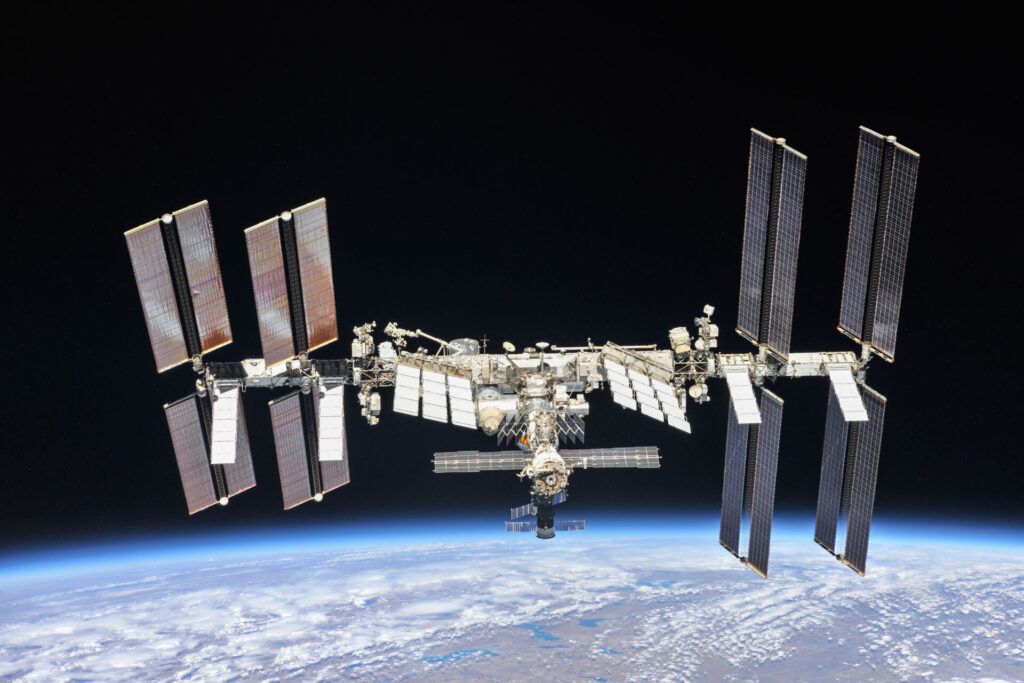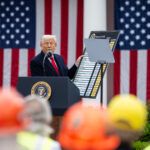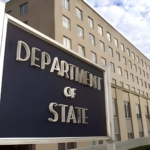The prospects for United States–China space cooperation are limited
By Aaron Bateman | June 12, 2023
 The International Space Station photographed by Expedition 56 crew members from a Soyuz spacecraft after undocking. Credit: NASA/Roscosmos, Public domain, via Wikimedia Commons
The International Space Station photographed by Expedition 56 crew members from a Soyuz spacecraft after undocking. Credit: NASA/Roscosmos, Public domain, via Wikimedia Commons
In July 1975, when an American spacecraft docked with a Soviet capsule, cosmonauts and astronauts shook hands 225 kilometers above the Earth to symbolize détente between the superpowers. This dramatic act contributed to hopes that space cooperation could be used to overcome geopolitical tensions below. In reality, the mission took place right before a new, intensified phase in superpower military space competition—a competition that lasted until the end of the Cold War.
In the past decade, space security has emerged once again as an urgent policy challenge. American defense officials have candidly warned about the prospect of conflict extending into space. Senior US intelligence experts have publicly described the increasingly sophisticated array of counter-space weapons being developed by China and Russia. At the same time, Beijing has accused the United States of being the “main driver turning outer space into a weapon and a battlefield.” Although the United States has a long history of cooperating with Russia in crewed spaceflight and continues to do so today despite a low point in relations with Moscow, there is no similar track record of Sino-American cooperation in crewed spaceflight. Moreover, US law forbids NASA from cooperating with its Chinese counterparts.
With tensions between the United States and China moving into space, some experts argue that it is vital to cooperate with China in the cosmos as a means of preventing space from becoming a battlefield. While there are some potential areas for cooperation, such as deconflicting lunar activities and communicating about potential hazards to human spaceflight operations, the lessons from the Cold War suggest that partnering with Beijing on space projects will not reduce military tensions in space, quite the contrary.
Historically, cooperative space projects have been a lagging indicator of relations between countries rather than a primary mechanism for lowering tensions. Moreover, in the United States-Soviet context, civil space cooperation took place as military tensions in space were on the rise. Fundamentally, there are potential benefits for limited forms of cooperation between Washington and Beijing to better coordinate and deconflict their respective space activities, but such endeavors are unlikely to soothe the growing tensions between the two on Earth and in the cosmos.
Superpower space cooperation during the Cold War. There is a persistent tendency to view space activities as constituting a special area of statecraft that is somehow free of geopolitical machinations. In reality, space activities are just another vehicle for promoting a state’s interest. Although policymakers have long spoken about using space projects to overcome political problems on Earth and to mitigate tensions in the cosmos, such a view overlooks the fact that actions in space are the result of a wide range of terrestrial political agendas. Space expert Bleddyn Bowen underlines this point with his observation that space activities do “not exist in a political and strategic vacuum.”
President John F. Kennedy’s legacy is forever tied to the Cold War space race due to his establishment of the Apollo program. The landing and safe return of the Apollo 11 crew was a triumph of American science and technology in the context of a global Cold War and is seen as the final, victorious act in a superpower race to the moon. But the success of the US lunar program casts a long shadow over Kennedy’s earlier interest in a joint lunar mission with the Soviets.
In 1963, Kennedy asked why “should man’s first flight to the moon be a matter of national competition?” Notably, Kennedy prefaced this question with the statement that the “clouds have lifted a little” in reference to a lowering of tensions between the superpowers. In other words, the proposed joint lunar mission would take place within the context of already improving United States-Soviet relations. Regardless, after Kennedy’s assassination President Lyndon Johnson had little interest in partnering with Moscow to go to the moon.
After the Apollo 11 landing in 1969, President Richard Nixon reoriented American civil space activities towards cooperative efforts rather than continued competition with the Soviet Union. By this point, American–Soviet relations were improving, and the superpowers were in the midst of the Strategic Arms Limitation Talks, which officially aimed to curb the arms race. In 1972, Nixon and Soviet Chairman Alexei Kosygin signed an agreement pledging that the superpowers would cooperate in the exploration of outer space.
This new spirit of cooperation between the superpowers culminated in the 1975 Apollo-Soyuz Test Project, in which an American and a Soviet spacecraft docked, followed by handshakes between the cosmonauts and astronauts. Historians have argued that this mission served as a “catalyst” for détente. But this perspective overlooks a fact: Détente was already faltering in 1975, and not even six months after this joint space endeavor, Moscow reinitiated testing of anti-satellite weapons in space. Consequently, Apollo-Soyuz in no way lowered the possibility for military conflict in space or on Earth. Moreover, in the final decade of the Cold War, space fast emerged as a domain of intensified superpower competition.
United States–Russia space cooperation after the Cold War. After the Cold War ended, space cooperation became a visible sign of the new relationship between Moscow and Washington. In 1993, United States Vice President Al Gore and Russian Prime Minister Viktor Chernomyrdin announced that they would work jointly on what ultimately became the International Space Station. The space station would assist Russia in maintaining an active space program, which had long been a source of pride and prestige, as the country attempted to recover from significant economic contractions.
Symbolism aside, the space station furthered vital US foreign policy objectives for the Russian Federation. In the early 1990s, there were thousands of unemployed Russian nuclear scientists, and keeping them employed on a civil space project in Russia helped to prevent them from providing their nuclear expertise elsewhere. The United States also supported Russia’s expansion of its commercial space-launch infrastructure, injecting financial resources into the cash-strapped Russian space program. As part of this deal, Moscow agreed not to sell missile technologies to countries that sought their own missile and nuclear programs.
In the past 20 years, United States cooperation with Russia in crewed spaceflight has endured despite a marked deterioration in relations. In part, this situation is due to the fact that the American and Russian components of the space station are interdependent. Astronauts and cosmonauts are both needed to keep their respective parts of the station operating. Consequently, even as geopolitical problems between Washington and Moscow have intensified, the space station has been a small enclave of peaceful cooperation. Although Russia announced in July 2022 that it would withdraw from the International Space Station after 2024, Russian officials have since pledged to continue participating until at least 2028.
At the same time, tensions between the United States and Russia have grown not only on Earth, but also in space. Moscow has reportedly been stalking American satellites in orbit, in addition to conducting an anti-satellite weapons test that produced a significant amount of harmful debris that will remain in orbit for some time. Alarmingly, debris from the anti-satellite weapons test was deemed a threat to personnel on the International Space Station, prompting them to shelter in place as a safety precaution.
This Russian anti-satellite weapons test underscores the reality that United States–Russia civil space cooperation has not mitigated the growing military tension between the two in space. Why is this the case? First, the International Space Station is the product of geopolitical conditions that no longer exist, and the greatest likelihood is that American–Russian space cooperation will end once the International Space Station dies. Second, military and civil space activities serve different goals. Just because two countries can find common purpose in a scientific or engineering project does not mean that they can resolve fundamental strategic-military differences.
The prospects for United States space cooperation with China. Unlike the Soviet Union and Russia, the United States does not have a history of substantive cooperation with China in crewed spaceflight. As China’s space capabilities have matured in the 21st century, mistrust between Washington and Beijing has only increased. In 2011, the US Congress passed the Wolf Amendment, which forbids NASA from cooperating with its Chinese counterparts without prior authorization. This legislation stemmed from growing awareness of Chinese theft of sensitive American technologies.
Concurrently, Beijing has been investing in a variety of military space capabilities, including weapons for degrading and destroying enemy satellites. In 2007, China conducted an anti-satellite weapons test, generating harmful debris that is still in orbit. According to the U.S. intelligence community’s public World Threat Assessment, China aims to “match or surpass” the United States in space.
China is clearly the peer-competitor for the United States in the space domain. Beijing now has its own permanently crewed station in low-Earth orbit and has substantial lunar ambitions, including a research base on the surface of the moon to be operated with Russia. Whether the latter actually materializes is an open question, especially due to Moscow’s growing resource constraints.
Some experts argue that the United States lost a great opportunity when it decided not to allow China to participate in the International Space Station. This line of reasoning suggests that had China become involved in the International Space Station, Beijing might not have invested so heavily in military space capabilities or in establishing its own space station. But this position is flawed. China’s space program serves as a means of elevating its prestige on the world stage, as a high-technology effort to develop advanced military systems that will improve its warfighting capacity and a mechanism to establish Chinese-led space alternatives to Western-run initiatives. Tensions between Washington and Beijing in space are just one component of broader geopolitical issues in their relationship.
When Joe Biden first came into the White House as president, several of his senior advisors asserted that a limited space partnership between Washington and Beijing “could reduce tensions and the likelihood of a destabilizing space race,” a move akin to cooperation between Washington and Moscow “during the height of the Cold War.” If the goal of space cooperation with China is reducing the prospect of a space arms race, then Cold War-era American–Soviet space cooperation does not provide a reassuring precedent. In practice, the Biden administration’s space policy towards China has been consistent with prior administrations.
The space situation with China is not, however, completely grim.
Setting realistic goals needs to be at the forefront of any discussion concerning space cooperation with China. Using civil space cooperation to lower geopolitical tensions is not feasible and there is no precedent for it. Cooperation in the form of joint space projects aside, Washington and Beijing could significantly benefit from more robust dialogue on space security and coordination of their respective space activities.
Currently, the United States and China are two of the most important actors on the world stage concerning setting norms of behavior in space, but they don’t fully agree on what the boundaries of activities in space should be. In 2022, the Biden administration announced a unilateral moratorium on destructive, direct-ascent, anti-satellite missile testing. Since then, 13 countries have joined the moratorium. But Russia and China refuse to adopt the moratorium despite arguably no longer needing to test these types of weapons, having done so in 2021 and 2007, respectively.
As American and Chinese lunar programs expand, it is vital that both countries deconflict their activities on the moon. To this end, setting up dedicated channels to have an established coordination process for missions to and from the moon is vital from a health and safety standpoint. Moreover, establishing a baseline of equipment standardization, especially for communications, would also help to ensure that Chinese and American personnel on the moon could assist each other in a crisis as well as more efficiently deconflict specific actions as needed.
The United States and other countries from around the world have agreed to deconfliction, safety, and information sharing concepts under the Artemis Accords initiative. As of May 2023, 24 countries have signed on, but the Chinese remain conspicuously absent. Beijing has shown only disdain for Artemis even though its stated goals of promoting a safe and transparent environment to facilitate civil space exploration, science, and commerce benefit all spacefaring nations.
Beyond lunar ambitions, American and Chinese civil, commercial, and military activities in space are likely to expand in the coming years. Now, with the advent of mega constellations involving hundreds of satellites, there will be more opportunities for collisions in space and an increase in risk to human spaceflight. In this context, establishing communication channels for health and safety issues in space is absolutely critical. Regardless of geopolitical tensions, no one wants to see a catastrophe in space that could create harmful debris or threaten human life.
Learning the wrong lessons from the Cold War. With geopolitical tensions between Washington and Beijing extending into space, it is only to be expected that policymakers are looking back to the Cold War for helpful lessons. Unfortunately, it is far too easy to learn the wrong lessons from space cooperation during and immediately after the Cold War. Certainly, space cooperation was not a silver bullet to superpower problems on Earth and in space. The pattern of space cooperation between the United States and Russia is an important reminder that space cooperation has generally been the product of improving relations rather than the catalyst for change.
Today there is little overt eagerness in either Washington or Beijing for space cooperation on the scale of joint American–Russian projects in the past. In any case, the key question for any prospective cooperative space endeavor between China and the United States must be: What is the end goal? And it would be wrong to conclude that large-scale American–Russian space endeavors provide a model for improving relations either on Earth or in space.
The political conditions that led to the International Space Station are remarkably different from the tense, competitive spirit that defines the Sino-American relationship at present. The International Space Station, like Apollo-Soyuz, is a remnant of a more harmonious atmosphere that no longer exists. Indeed, the symbolism attached to the American–Russian space cooperation is now an anachronism, especially in the context of the war in Ukraine.
Despite these difficult realities, there is still cause for some hope. Space cooperation is not a dichotomous, all or nothing situation. The United States and China can, and should, act to better coordinate their activities in space. Doing so not only benefits them, but all spacefaring nations. At this same time, it would be shortsighted to expect limited forms of coordination and deconfliction in space to significantly mitigate Sino-American geopolitical tensions. Fundamentally, civil space cooperation and military space competition are not mutually exclusive.
The task for policymakers now is to devote their energies to finding ways to reduce at least two types of risks: the first being the daily hazards associated with conducting space operations; and the second relating to the risk of misperception, miscalculation, and misunderstanding which may cause inadvertent escalation or even conflict in space. Certainly, another project that produces only a handshake in space is not a solution to the increasingly acrimonious relationship between Washington and Beijing both on Earth and in the cosmos, but there are clearly limited paths forward which would still serve both nations’ goals.
Together, we make the world safer.
The Bulletin elevates expert voices above the noise. But as an independent nonprofit organization, our operations depend on the support of readers like you. Help us continue to deliver quality journalism that holds leaders accountable. Your support of our work at any level is important. In return, we promise our coverage will be understandable, influential, vigilant, solution-oriented, and fair-minded. Together we can make a difference.
Keywords: Apollo, China, Cold War, Russia, Soyuz, international space station, space
Topics: Disruptive Technologies
















We primarily cooperated with the Russa in space for one obvious reason. After shuttle failures, the Russians had the only affordable reliable launch rocket–absolutely required for a space station. .